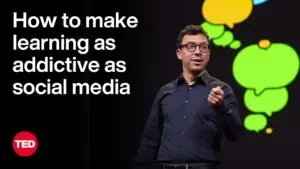
Key Takeaways
- Adapting everyday life to the language of choice can be a great advantage
- Variety of resources and modes of learning help keep things interesting
- Regular practice, even in short periods, makes a big difference
- It’s never too late to start learning a language, and everyone can find a suitable approach.
Nathan, whose remarkable progress in learning Spanish has gathered attention on social media, shares his tips and strategies, giving an insight into what makes a successful language learning routine.

✅ AI Essay Writer ✅ AI Detector ✅ Plagchecker ✅ Paraphraser
✅ Summarizer ✅ Citation Generator
An Engaging Cycle
Nathan attributes his success to an engaging cycle of monthly practices that keeps his learning journey interesting. He reveals, “Today is reading newspapers day!” Hence, integrating language learning into everyday activities proves to be a practical approach. Mark, another language learner, says, “It’s evolved over the 10 months I’ve been learning… The only extra is the vocab study.”
Immersive Language Learning
Nathan, like many others, emphasizes the importance of listening for language learning. He recommends choosing original content produced in the target language, reinforcing his skills through the immersive experience it provides. Auditory learning, he argues, significantly enriches vocabulary, improves pronunciation, and enhances comprehension skills in the target language.
Nathan highlights, “Twice a week or so I watch a movie or TV show in my TL. I hate dubbing though so it has to be originally produced in Spanish, I’m lucky to be learning a language with so much content.” The diversity of auditory content, from movies and podcasts to music, allows for a more natural grasp of linguistic nuances, tones, and accents that textbooks may not fully provide.
This sentiment is shared by other learners like Jack who advises, “I specifically search for content I want to watch and focus on listening. Audiobooks are best for me because I can listen for a long time without touching my phone.” Audiobooks and long-form podcasts, as Jack suggests, provide prolonged exposure to the language, helping the brain to better adapt to its rhythm and structure, even enhancing cognitive abilities and multitasking skills.

Another important benefit of this method is the way it enables learners to assimilate the language’s culture, idioms, and expressions, giving them a deeper understanding and appreciation of it. Listening can be a practical and entertaining way to learn a language, making the process more enjoyable and less of a chore.
Maximizing Resources
A key theme among the students’ responses is the innovative use of resources, both traditional and modern. This balance offers a well-rounded approach to language learning, utilizing the unique benefits of different tools and creating a holistic and engaging learning experience.
Julia shares, “I like having a monthly practice cycle with lots of different resources to keep things interesting. Today is reading newspapers day!” Traditional resources such as newspapers provide real-world language context that includes current vernacular, slang, and topical issues which contributes to cultural literacy – an important aspect of language learning.
Notably, embracing technology in language learning emerged as an essential part of most routines. For instance, Sarah states, “2 quick Duolingo lessons in the morning… 2 more Duolingo lessons at night.” Online tools like Duolingo provide interactive, bite-sized lessons that make it easy to practice on the go and keep consistent with learning.
Meanwhile, Ben makes the case for blending old and new techniques: “I do a lesson on Duolingo every couple of months or so and forget about it in between… I’m almost C1 and I’ve been learning for over 10 years.” While this approach may not be for everyone, it does highlight the flexibility that a mix of resources can provide, accommodating different learning paces and styles.
Learning through Listening
The power of auditory learning remains a cornerstone in the students’ approach to language acquisition. By listening to content in the target language, learners can attune their ears to the unique sounds and rhythm of the language, and even pick up colloquial phrases and slangs.
Sam reveals, “I’m driving or walking I will usually put on the Duolingo podcast or No Hay Tos (20min).” He demonstrates that learning a language can be seamlessly integrated into daily routines. It also highlights the usefulness of podcasts as a tool for passive learning – learners can absorb the language without actively studying, thereby reducing the risk of burnout.
Another student, Susan, insists on viewing content originally produced in the target language: “Twice a week or so I watch a movie or TV show in my TL. I hate dubbing though so it has to be originally produced in Spanish.” This allows learners to gain a sense of the cultural context and use of language in its natural form.
Lana supplements this by suggesting long-form auditory content, such as audiobooks or podcasts, for extended language exposure: “Audiobooks are best for me because I can listen for a long time without touching my phone. Same thing with longer podcasts.” This extended exposure helps learners get used to the speed and intonation of native speakers, which can vastly improve comprehension skills over time.
Conclusion
Nathan’s journey of learning Spanish serves as a source of inspiration and practical advice for language learners. His approach, rooted in immersion, diversity of resources, regular practice, and auditory learning, shows that learning a language can be integrated into daily life in enjoyable and manageable ways.
Related stories:
TOEFL Exam Duration Cut by an Hour in Response to Market Shifts and Competition from Duolingo
Is Discord a good place to learn a language and join a language learning community?
iTalki & Preply Tutoring, Duolingo & Immersion: Top Language Learning Stories of the Month
Follow us on Reddit for more insights and updates.





Comments (0)
Welcome to A*Help comments!
We’re all about debate and discussion at A*Help.
We value the diverse opinions of users, so you may find points of view that you don’t agree with. And that’s cool. However, there are certain things we’re not OK with: attempts to manipulate our data in any way, for example, or the posting of discriminative, offensive, hateful, or disparaging material.